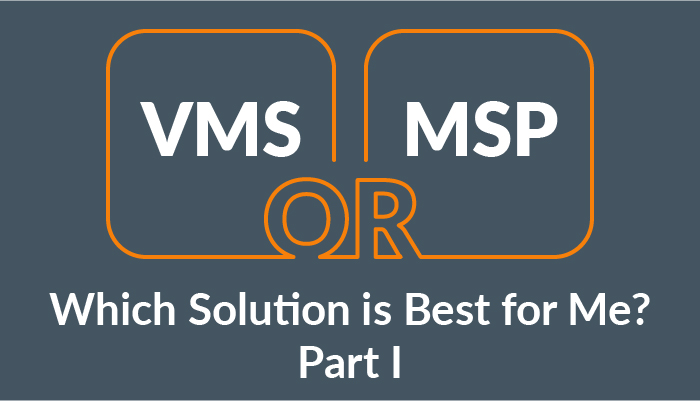VMS? MSP? Which Solution is Best for Me? Part One of a Three Part Series | Is VMS Best?

Back in March, we published a post on the Top Four Considerations for Successful VMS Implementations. In the wake of that article, we were peppered with questions from prospective customers regarding how they can be certain that a VMS-only solution (a solution that does not incorporate an MSP) is the right prescription for their organization to manage their contingent workforce. After all, it makes sense to be sure the VMS is the right action before you consider what’s required to ensure a successful implementation. So here is some valuable perspective on how to determine if your company/organization is a good candidate for VMS-only solutions.
When nextSource is asked by a customer organization if the time and environment is right to select and deploy a vendor management system platform, there are a number of important questions we pose to the customer. The answers to which should clarify whether or not a VMS-only solution makes sense for the organization.
Question 1 | Does the organization possess the internal expertise necessary to determine and articulate the workflows and business processes necessary to properly configure a VMS solution?
Applying a technology solution to existing business practices, workflows, etc., often requires taking a look at how existing workflows and practices might be re-engineered in order to get the optimal result from automation technology. Often, organizations will assume the application of the technology will be the means to drive improvement in process efficiency. However, if your existing resources are not clear on where the challenges lie, no tool, no matter how powerful, will effectively achieve process improvement. Configuring a powerful new tool to automate poor/inefficient workflows is a recipe for failed implementations.
Question 2 | Do you have the internal resources needed to manage a contingent workforce?
Supposing there is enough existing expertise in the areas discussed in Question 1, there is still the question of whether, once up and running with a newly deployed VMS, the organization has the policies and structures in place to actively and effectively manage the increased numbers of contingent workers they’ll be hiring as a result of improved supplier management and other VMS benefits. It is a bit of “cart-before-horse” thinking to stand up a VMS solution before there are robust contingent workforce management plan and strategies in place. Additionally, you will have great data, and aligned suppliers, but are the internal resources set up to analyze the data to improve outcomes and manage supplier performance?
These first two questions both point to the broader question of overall levels of resource availability within an organization seeking to deploy VMS. Larger companies for example are more likely to have the inherent bandwidth and expertise – both in workforce management/HR and IT – necessary to focus on a VMS project. Smaller companies may find it more effective to engage an MSP first, relying on an MSP partner to lead tech process, change management, supplier strategy, training and rollout, before then leveraging the expertise of the MSP partner to help deploy a VMS. Staffing Industry Analysts (SIA) note that MSPs routinely handle approximately 62% of the workload involved in implementing a VMS solution. They certainly have the workforce management process experience needed to properly re-engineer processes and configure the system properly. Which prompts the obvious question…
Question 3 | Are you prepared to align bill rates with suppliers in such a way as to avoid having to revisit them again shortly if the organization intends to field an MSP solution after deploying VMS?
If you’re a larger company and embark on a VMS deployment first, confident that your internal resources are up to the task, then you must be sure to understand that any changes in the bill rate structure may be impacted if you elect to stand up an MSP as a “Phase II” step along your contingent workforce management roadmap.
To conclude, it depends on your answers to the three questions detailed above and the overall size and scope of your existing operations whether to deploy a VMS. Without the expertise needed to stand up a technology, an organization will be at a disadvantage when it comes to capturing the total value of a VMS. For a larger organization with the required internal resources, it can make sense to stand up the VMS and then, based on the visibility and control they achieve, weigh the benefits of outsourcing the supplier management to an MSP.
Part II of this series examines how to determine if your organization is a good candidate for an MSP solution.
To read more on this subject, turn to nextSource for expert guidance and visit our Managed Service Provider page.
“